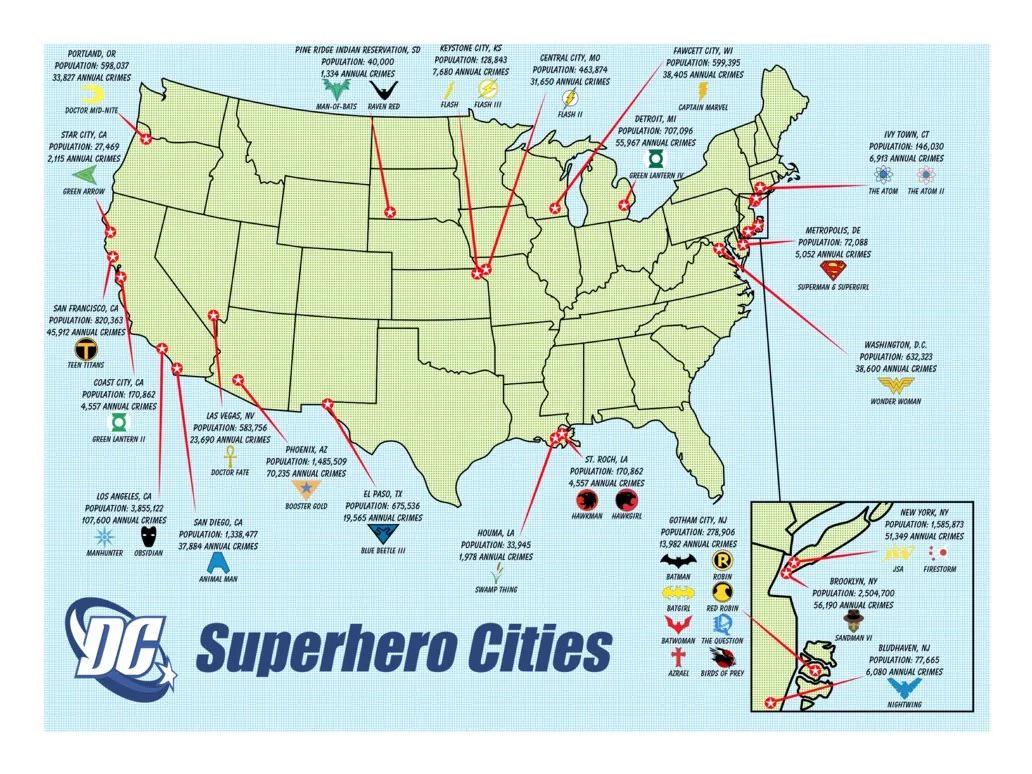Map of DC Comics Cities and Heroes


Marcus Rodriguez
Historical Geography Expert
Marcus Rodriguez specializes in historical cartography and geographic data analysis. With a background in both history and geography, he brings unique...
Geographic Analysis
What This Map Shows
This intriguing map visualizes the various fictional cities within the DC Comics universe and highlights the iconic heroes that protect them. From Gotham City, shrouded in darkness and crime, to Metropolis, the shining beacon of hope, each location is rich with its unique storylines and characters. The map not only showcases the geographical placements of these cities but also reflects the dynamic interplay between the heroes and the environments they inhabit.
Deep Dive into DC's Fictional Cities
DC Comics has created a diverse array of fictional cities, each serving as a backdrop for epic tales of heroism and villainy. Gotham City, perhaps the most famous, is characterized by its Gothic architecture and crime-ridden streets. It is the home of Batman, who tirelessly combats the likes of the Joker and Scarecrow. Interestingly, the dynamics of Gotham reflect urban challenges like crime and corruption, serving as a metaphor for real-world issues.
Metropolis, in contrast, represents an idealized American city, filled with gleaming skyscrapers and a sense of optimism. Superman, the city's protector, embodies hope and justice, often standing as a stark contrast to the darker elements of Gotham.
Beyond these two, the map includes other noteworthy cities such as Star City, home to Green Arrow, and Central City, where The Flash races against time. Each city is not only a setting but a character in its own right, influencing the motivations and challenges faced by its heroes. For instance, Star City’s socioeconomic issues provide a fertile ground for Green Arrow’s brand of vigilante justice, focusing on social justice and wealth disparity.
Moreover, fictional cities like Coast City, the home of Green Lantern, and Themyscira, the hidden island of Wonder Woman, showcase a blend of human and mythological elements, enriching the narrative landscape of the DC Universe. The inclusion of these diverse settings emphasizes the importance of place in storytelling, allowing readers to connect with the heroes on a deeper level.
Regional Analysis
When examining the map, it becomes clear that the geography of DC's cities is intentionally designed to reflect the characteristics of their respective heroes. For instance, Gotham's placement on the map often suggests a more northern latitude, which can be associated with colder climates and longer nights, mirroring Batman’s dark persona and relentless nature.
Conversely, Metropolis is typically depicted near coastal areas, symbolizing openness and light. This geographical positioning not only highlights the contrast between the two cities but also enhances the narrative tension between their heroes. Have you noticed how the geography often plays a critical role in defining the heroes' abilities and challenges?
Star City, located on the west coast, is a place of innovation yet plagued by corruption, reflecting the duality of its hero Green Arrow. This duality is evident in the city's portrayal as both a vibrant urban center and a struggling environment needing change. Central City, home to The Flash, is often depicted as a hub of technology and speed, emphasizing the hero's abilities and the rapid pace of life there.
Significance and Impact
Understanding the geography of DC Comics' cities and the heroes that protect them is significant for several reasons. Firstly, these fictional places serve as allegories for real-world social issues, making them relevant to contemporary audiences. The struggles faced by characters in cities like Gotham and Metropolis resonate with societal challenges such as crime, inequality, and hope.
Moreover, the map serves as a reminder of how geography shapes narratives. The heroes are often reflections of their environments, and their challenges are rooted in the landscapes they inhabit. As we witness the evolving narratives within these cities, we can draw parallels to real-world urban issues, making the stories all the more impactful.
Interestingly, as DC Comics continues to expand its universe, the geographical landscape of these cities may evolve, potentially introducing new heroes to combat modern-day dilemmas. The future of these fictional cities could reflect shifts in societal values, environmental concerns, or even technological advancements, prompting readers to engage with the stories on multiple levels.
In conclusion, the map of DC Comics' fictional cities and their heroes not only illustrates geographical placements but also invites us to ponder the deeper connections between place, character, and the narratives that unfold within these vibrant, imaginative landscapes.
Visualization Details
- Published
- August 17, 2025
- Views
- 148
Comments
Loading comments...